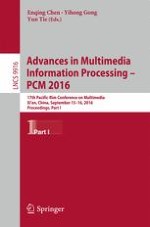2016 | Book
Advances in Multimedia Information Processing - PCM 2016
17th Pacific-Rim Conference on Multimedia, Xi´ an, China, September 15-16, 2016, Proceedings, Part I
Editors: Enqing Chen, Yihong Gong, Yun Tie
Publisher: Springer International Publishing
Book Series : Lecture Notes in Computer Science
